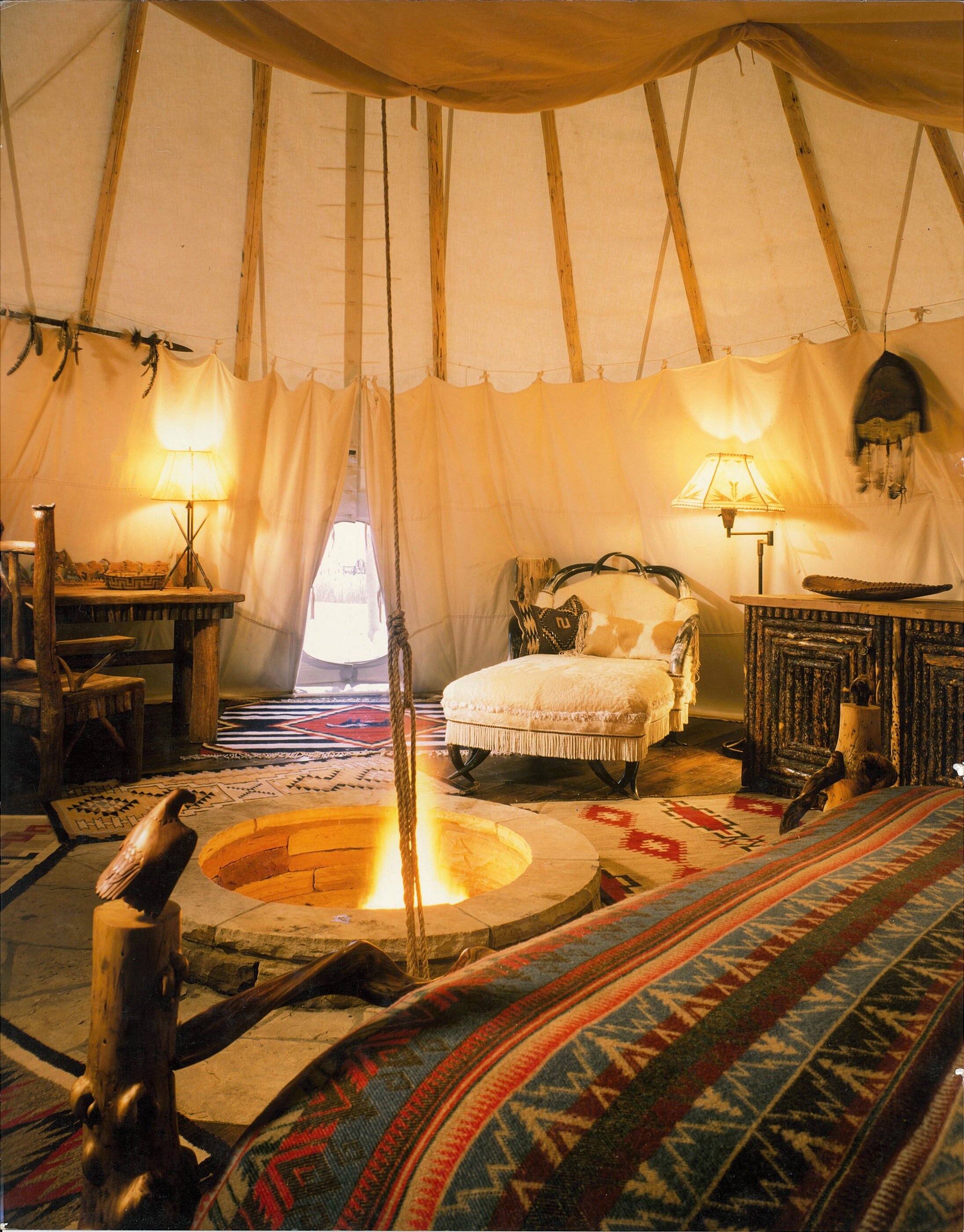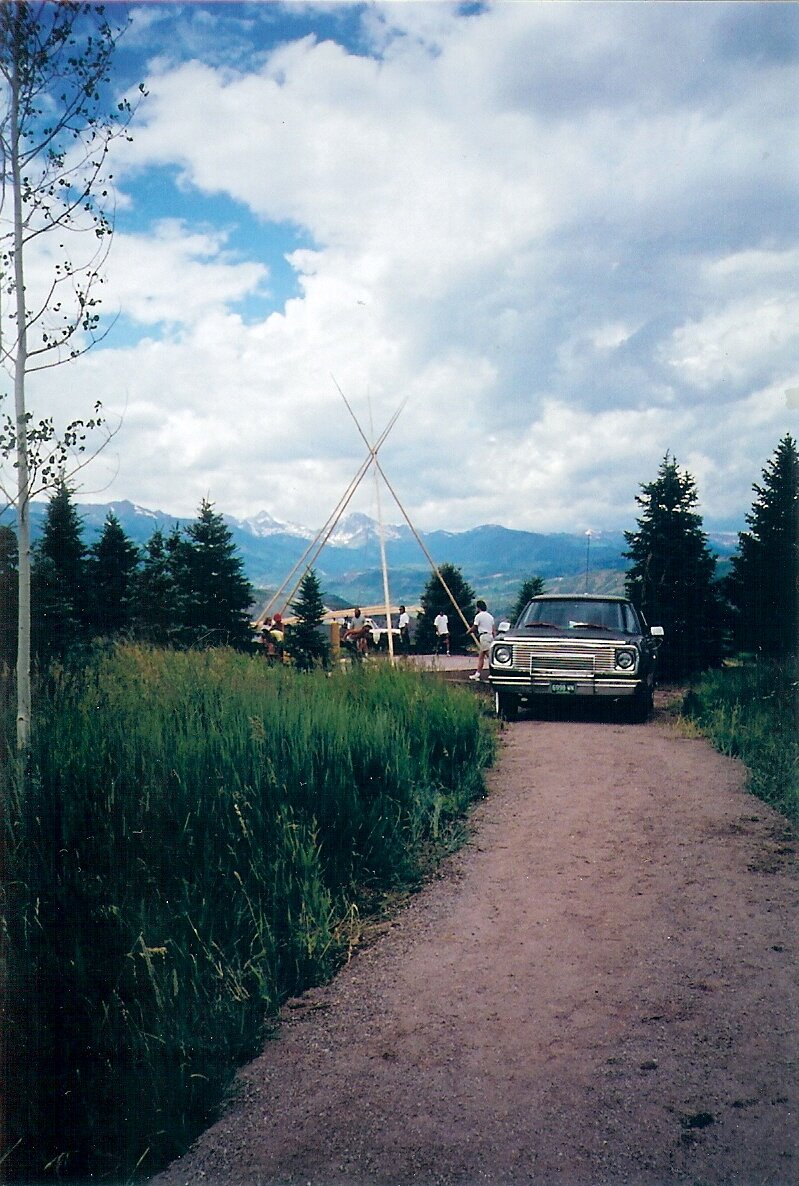
Taming of a Tepee
Taming of a Tepee…a Western Fantasy in Aspen
As Cassandra was walking down a sidewalk in Aspen one afternoon, her friend Gregg Abbott drove up beside her saying, “Hey I have a design project for you. It’s a tepee!” Thinking that he was kidding, she replied “Thanks Gregg, but I don’t do tepees.” As he drove off on his yellow Harley, he said with a smile “You’ll be doing this one!” Interestingly, that same evening Cassandra attended a dinner party at Dewey Sukarno’s home to honor the birth of the great “White Buffalo.” Mrs. Sukarno, the former first lady of Indonesia, requested that all guests wear white. As serendipity would have it, Cassandra was seated next to a tall Native American man by the name of John Eagle Day. As dinner guests around the table engaged in various conversations, Cassandra mentioned the potential tepee project to Eagle Day, asking if he had any ideas on how one might be made? It was on that night that the tepee project was launched!
As John Eagle Day spearheaded arrangements with lodgepole cutters in Montana, and a tepee craftsman team in Colorado, Cassandra searched for the most unique hand crafted furniture, rugs and accessories for the interior. The building contractor’s participation included a solid foundation with a stone fire pit, hardwood flooring and electricity.
Six months later when the tepee was installed and the interior design was complete, it immediately attracted the attention of Architectural Digest magazine. The tepee was soon awarded with the magazine’s cover along with a feature article that was published around the world. “The Taming of a Tepee” soon became one of the bestselling issues in the magazine’s history. The project was featured again in Architectural Digest’s special edition “100 Years of Design” and showcased on national television, including HGTV and CBS Morning News.
The tepee was honored on the cover of Architectural Digest.
See full Architectural Digest piece here.
The 36 foot lodgepoles were hand-selected from the forests of Montana, and hand-peeled. Arrangements were made to transport the poles from Montana to Colorado on a large semitruck. Of course the semitruck couldn’t make it up the steep and curving mountain roads once it arrived in Aspen. From there, the lodgepoles were precariously moved by an open truck bed to the Starwood installation site.
Cassandra and John Eagle Day on the day of installation
The canvas is installed.
“Every time I’d ask John a question like ‘Will it be dangerous to have electricity in a tepee?” or “What about damage from rain and snow to the expensive interiors?” he’d just laugh and say, ‘Cassandra you’re trying to cage a wild animal.’”
The first frame work goes up.
“Selecting a cover for Architectural Digest was always an interesting challenge. With projects from all over the world in each issue, we had numerous striking images to choose from. In 1994, we had accepted a wonderful story by designer Cassandra Lohr: a fully furnished tepee in the mountains near Aspen. While we were sifting through images for the cover of that issue, one image kept drawing our attention: a twilight shot of the opening of a glowing tepee, the interior warm and inviting against the darkening mountain sky. Taken by David Marlow with Cassandra’s direction, the image stood out in a unique way. A tepee on the cover of Architectural Digest? We thought, why not try it? When we saw the newsstand reports afterward, we were pleasantly surprised. That issue was one of the best-selling issues of Architectural Digest ever. Perhaps it was the primal sense of shelter and warmth and the romance of the West that connected with readers. Perhaps it was the sheer beauty of the photograph and Cassandra’s design. Most likely it was a combination of all of these factors. In any event, it represented the kind of “lightning in a bottle” that we always sought in our covers, and it remains memorable to this day.”
Cassandra employed the talents of many of the best craftsman to be found. Native American furniture-maker, Shenandoah, hand crafted the king size bed with carved eagles. The custom bedding included red hand laced glove leather, and a blanket fabric from the Ralph Lauren collection. The meticulously made Adirondack cabinet to the left featured a large pop up television, a stereo system, and wine bar.
Architectural Digest: “The client wanted a whole house in a twenty-eight-foot-diameter space.” explained Cassandra Lohr, who designed the interior of a tepee on her clients’ Aspen property.”
The sofa was made of hand-laced natural edge elk hides. It was custom made with a slight curve to conform to tepee’s oval shaped structure. The hand-carved “running buffalo” desk and chair were created for the tepee by Cody master craftsman, Wally Reber.
The steer horn chaise lounge was upholstered with a French Charolais hair on hide, and trimmed with matching silk bullion.








